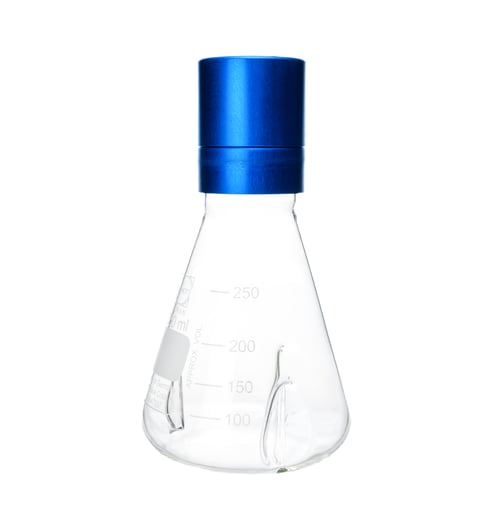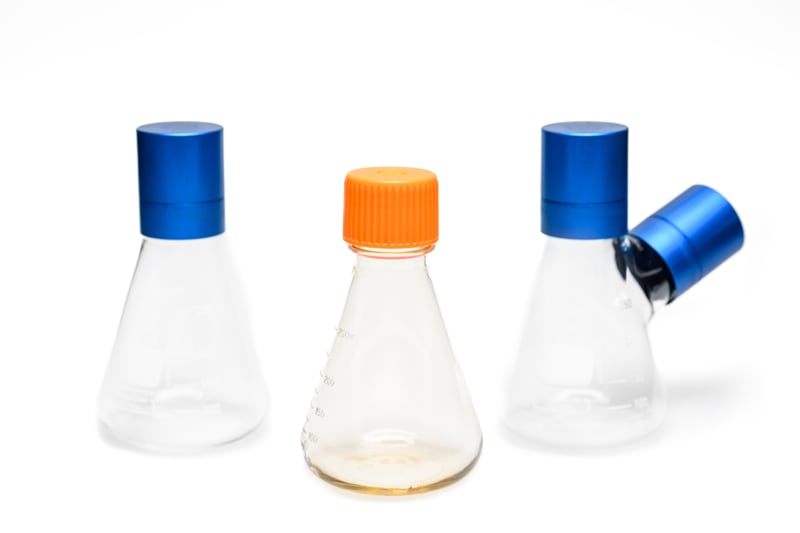Baffled Versus Non-baffled Shake Flasks: What You Need To Know

Microbial shake flask experiments are the lifeblood of biotechnological research, providing a controlled environment for microbes to thrive. Microbes, used in various biotechnological applications, rely on oxygen, carbon, nitrogen, phosphate, and trace elements for growth and production. Oxygen, a critical element for microbial growth and production, is a focal point in optimizing these experiments and ensuring proper oxygen supply is vital.
Understanding how oxygen reaches microbes in shake flask cultivations involves a journey from the ambient air through the flask closure into the liquid phase. The oxygen transfer rate (OTR) and oxygen uptake rate (OUR) are crucial considerations, with filamentous, aggregated, and fungal organisms because measuring the biomass presents additional challenges here.
Several factors influence oxygen transfer into the liquid phase and understanding them is crucial for optimizing microbial cultures. These factors include the surface/volume ratio, filling volume/shake flask size, shaking frequency/shaking diameter, flask wall properties (hydrophobic/hydrophilic), viscosity, and osmolarity/salinity. Empirical equations, such as those proposed by Kristina Meier*, can help quantify these influences.
When contemplating parameter changes to enhance oxygen uptake, it is essential to align these adjustments with microbial needs. While more oxygen may be beneficial for growth, certain microbes may exhibit improved production in microaerophilic conditions. Striking a balance is key to achieving optimal results in microbial shake flask experiments.
Let’s compare the advantages of baffled flasks and non-baffled flasks, shedding light on the pros and cons of each approach in the context of oxygen supply to microbial cells.
Baffled Shake Flasks

Baffled flasks are designed with indentations or baffles along the inner surface, aiming to improve oxygen transfer rates (OTR) within the liquid phase. Baffled flasks facilitate higher oxygen transfer rates, ensuring microbes receive an ample supply for growth and production. The strategic placement of baffles creates a more favorable surface/volume ratio, optimizing the contact between the liquid phase and ambient air for efficient oxygen uptake. Baffles aid in preventing stratification and promote better mixing, reducing the likelihood of oxygen-deprived zones within the flask. Baffled flasks can be advantageous when working with filamentous, aggregated, or fungal organisms, overcoming some of the challenges associated with their complex morphologies.
However, despite these advantages, baffled flasks come with their own set of challenges. Achieving consistent results across multiple experiments can be challenging due to variations in flask design, baffling patterns, and manufacturing processes. Increased turbulence within baffled flasks may lead to excessive foam formation, necessitating
additional measures to control foam and prevent potential cell damage. The enhanced mixing in baffled flasks may introduce shear stress, affecting the integrity of delicate microbial cells and potentially impacting their performance. Baffled flasks present difficulties in applying mathematical models due to their complex design, making it challenging to predict and control oxygen transfer accurately.
Non-baffled Shake Flasks

In contrast, non-baffled flasks lack the internal indentations, offering simplicity in design. Due to this simpler design allows for facilitating greater reproducibility across experiments. The absence of baffles generally results in less turbulence, minimizing foam formation and simplifying experimental control. Non-baffled flasks may subject microbes to lower shear stress, which can be advantageous for delicate cells sensitive to mechanical forces.
However, simplicity comes with trade-offs. Non-baffled flasks may exhibit lower oxygen transfer rates, potentially impacting microbial growth and production.
Conclusion
The choice between baffled and non-baffled flasks hinges on the specific needs of the microbial strain and the goals of the experiment. Researchers must weigh the advantages and challenges of each approach, considering factors such as reproducibility, foam formation, shear stress, and the ability to apply mathematical models. Whether opting for enhanced oxygen transfer or a simpler design, understanding the nuances of baffled and non-baffled flasks is crucial for successful biotechnological advancements.